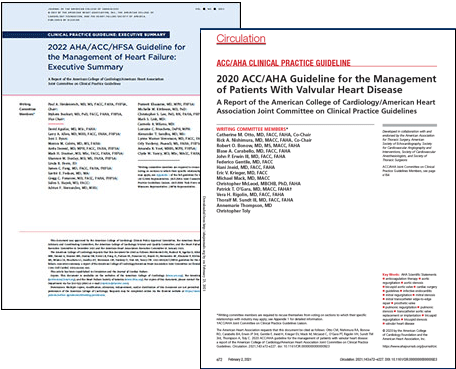Life-Changing TEER Therapy for Select Patients with Mitral Regurgitation
MitraClip™ is the world’s first mitral transcatheter edge-to-edge repair (TEER) therapy — also referred to as TMVr (transcatheter mitral valve repair) — that delivers a minimally invasive treatment option for select patients with primary or secondary mitral regurgitation (MR).1,2 With more than 20 years of clinical experience and over 200,000 patients treated worldwide, MitraClip™ is a well-established procedure with the highest-reported to date MR reduction, proven safety and survival, and durable clinical outcomes.3,4
Learn about the features and clinical performance of the MitraClip™ TEER System.
Both AHA/ACC/HFSA and the ACC/AHA Guidelines Favor Intervention
Transcatheter edge-to-edge repair (TEER) therapy is recommended by the 2022 AHA/ACC/HFSA5 and the 2020 ACC/AHA Guideline6 for select primary and secondary* MR patients. Determining the severity of MR is an important factor in the management of the condition. The guidelines support aggressive monitoring and early action, with the goal of preventing complications due to left ventricular volume overload.5
*Secondary MR patients with persistent symptoms despite optimal guideline-directed medical therapy (GDMT).

Learn more about MitraClip™ TEER by visiting the Abbott Structural Heart website
Ordering Information
MitraClip™ G5 TEER System
| Product Code | Description | Piece Count |
|---|---|---|
| MCG50100 | MitraClip G5 System | 1 |
| CDS0801-NT | MitraClip G5 NT Clip Delivery System | 1 |
| CDS0801-NTW | MitraClip G5 NTW Clip Delivery System | 1 |
| CDS0801-XT | MitraClip G5 XT Clip Delivery System | 1 |
| CDS0801-XTW | MitraClip G5 XTW Clip Delivery System | 1 |
| SGC0801 | MitraClip G5 Steerable Guide Catheter | 1 |
Required Accessories
| Product Code | Description | Piece Count |
|---|---|---|
| SZR08 | Stabilizer | 1 |
| LFT07 | Lift | 1 |
| PLT07 | Support Plate | 1 |
MitraClip™ G4 System
| Product Code | Description | Piece Count |
|---|---|---|
| MCG40100 | MitraClip G4 System | 1 |
| CDS0706-NT | MitraClip G4 NT Clip Delivery System | 1 |
| CDS0706-NTW | MitraClip G4 NTW Clip Delivery System | 1 |
| CDS0706-XT | MitraClip G4 XT Clip Delivery System | 1 |
| CDS0706-XTW | MitraClip G4 XTW Clip Delivery System | 1 |
| SGC0701 | MitraClip G4 Steerable Guide Catheter | 1 |
Required Accessories
| Product Code | Description | Piece Count |
|---|---|---|
| SZR01ST | Stabilizer | 1 |
| LFT01ST | Lift | 1 |
| PLT01ST | Support Plate | 1 |
References
- MitraClip G5 Instructions for Use.
- Lim DS, et al. Improved functional status and quality of life in prohibitive surgical risk patients with degenerative mitral regurgitation after the transcatheter mitral valve repair. J Am Coll Cardiol. 2014;64(2):182-192.
- Data on file at Abbott.
- von Bardeleben R, Mahoney P, Morse M, et al. 1-Year Outcomes With Fourth-Generation Mitral Valve Transcatheter Edge-to-Edge Repair From the EXPAND G4 Study. J Am Coll Cardiol Intv. 2023 Nov, 16 (21) 2600-2610.
- Heidenreich PA, Bozkurt B, Aguilar D, et al. 2022 AHA/ACC/HFSA Guideline for the Management of Heart Failure: A Report of the American College of Cardiology/American Heart Association Joint Committee on Clinical Practice Guidelines. J Am Coll Cardiol. 2022 May;79(17):e263-e421
- Otto C, et al. 2020 ACC/AHA Guideline for the Management of Patients with Valvular Heart Disease: A Report of the American College of Cardiology/American Heart Association Joint Committee on Clinical Practice Guidelines. Corrected version. Circ. 2021;143(5):e72-e227.
MAT-2100249 v5.0
